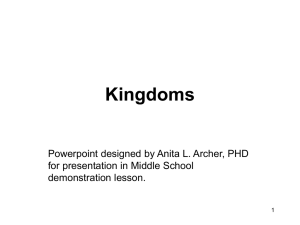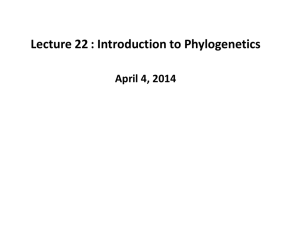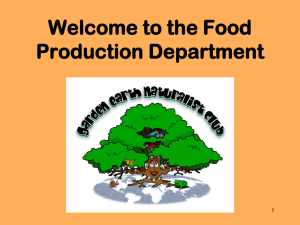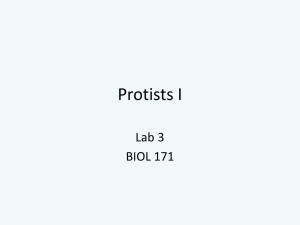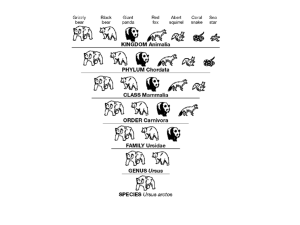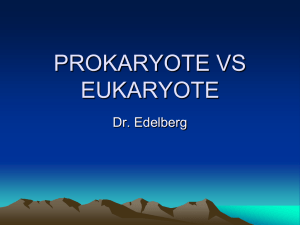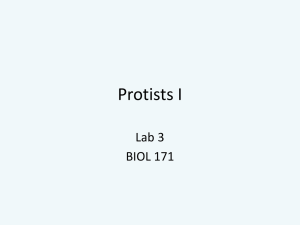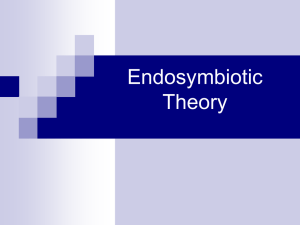The flux of energy and matter
advertisement
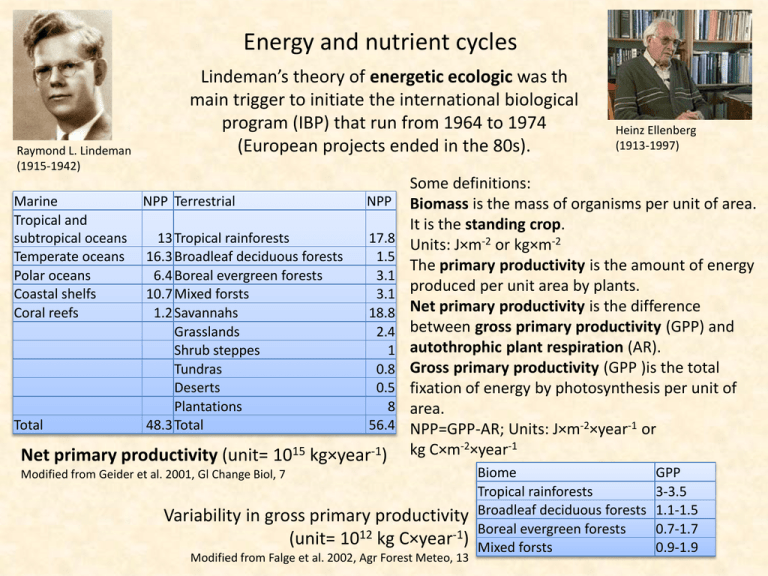
Energy and nutrient cycles Raymond L. Lindeman (1915-1942) Marine Tropical and subtropical oceans Temperate oceans Polar oceans Coastal shelfs Coral reefs Total Lindeman’s theory of energetic ecologic was th main trigger to initiate the international biological program (IBP) that run from 1964 to 1974 (European projects ended in the 80s). NPP Terrestrial NPP 13 Tropical rainforests 16.3 Broadleaf deciduous forests 6.4 Boreal evergreen forests 10.7 Mixed forsts 1.2 Savannahs Grasslands Shrub steppes Tundras Deserts Plantations 48.3 Total 17.8 1.5 3.1 3.1 18.8 2.4 1 0.8 0.5 8 56.4 Net primary productivity (unit= 1015 kg×year-1) Some definitions: Biomass is the mass of organisms per unit of area. It is the standing crop. Units: J×m-2 or kg×m-2 The primary productivity is the amount of energy produced per unit area by plants. Net primary productivity is the difference between gross primary productivity (GPP) and autothrophic plant respiration (AR). Gross primary productivity (GPP )is the total fixation of energy by photosynthesis per unit of area. NPP=GPP-AR; Units: J×m-2×year-1 or kg C×m-2×year-1 Biome Tropical rainforests in gross primary productivity Broadleaf deciduous forests Boreal evergreen forests (unit= 1012 kg C×year-1) Mixed forsts Modified from Geider et al. 2001, Gl Change Biol, 7 Variability Heinz Ellenberg (1913-1997) Modified from Falge et al. 2002, Agr Forest Meteo, 13 GPP 3-3.5 1.1-1.5 0.7-1.7 0.9-1.9 The earth energy budget Sun 100% = 1.7 1017 Watt radiation 42 reflected radiation 0.002 100 Heat energy 23 23 34 1 0.018 Atmosperic water Plants Fossilized energy Only 0.023% (4 1013 Watt) of the incoming radiation of the sun is converted in organic matter Wind 0.023 Fungi 0.006 Bacteria Tidal energy Animals 0.006 Humans Geothermal energy The global oxygen cycles OH O O2 Atmosphere H2O UV H2O O O2 H O2 O2 O3 Oxydation O2+2CO→ 2CO2 Photosynthesis Respiration Biosphere Water cycle Pedosphere Hydrosphere O2 Vulcanism CO O2+4FeO→ 2Fe2O3 Bleaching Ground water Litosphere The major oxygen producers are marine algae and terrestrial green plants. The major processes that reduce atmospheric oxygen are CO and iron oxidation. Local and global flux of matter in the biosphere Global cycles of main elements: C, N, O, H Local cycles of P and of trace elements: K, Ca, Mg, Cu, Zn, B, Cl, Mo, Mn, Fe Atmosphere Bacteria Plants Plants Soil Consumers Soil Consumers Litter Decomposers Litter Decomposers Amount of radiation that reaches the biosphere 83% The energy budget of the biosphere 100% 40% 3% 57% 17% Net production P is calculated from 𝑃 = 3.7𝑘𝑅𝐶 3.7: average carbon fixation rate of chlorophyll R: relative photosynthesis rate, k: extinction coefficient × m-1 (1 in terrestrial systems) C: amount of chlorophyll × m-3 1-3% 57% Global average energy budget On average about 10% of energy is transmitted from one trophic levels to the next. The marine potential productivity depends on latitude and season. NPP increases with standing crop Modified from Whittaker, 1975, Ecol. Monogr, 23. Photosynthetic effeciency differs betwen habitat types Modified from Webb et al., 1983, Ecology, 64. Photosynthetic effciciency in the Argentine pampas is limited by water and temperature. Modified from Jobbagy et al. 2002, Ecology, 83 The rate of energy transferred to the next trophic level depends on habitat type and NPP. Modified from Cebrian 1999, Am Nat, 154. P: Production at trophic level n 𝐶𝐸 = 100 × 𝐼𝑛 𝑃𝑛−1 Consumption efficiency I: Consumption at trophic level n 𝑇𝐸 = 100 × 𝑃𝑛 𝑃𝑛−1 Transfer efficiency 𝐴𝑆 = 100 × P: Assimilation at trophic level n 𝐴𝑛 𝐼𝑛 Assimilation efficiency 𝑃𝐸 = 100 × 𝑃𝑛 𝐴𝑛 Production efficiency The global cycle of potentially biologically active carbon Plant respiration 50 Microbial respiration 60 Atmosphere 720 × 1012 kg Human emissions 7.7 Land use 1.5 93 Photosynthesis 123 90.2 Plant and fungal biomass 600 Soil carbon 2,300 Ocean surface 700 Deposition 13 Deep ocean 2.8 1,000 Reactive sediments >6,000 Fossil carbon >5,000 Th annual increase of athmospheric carbon from fossil fuel burning Atmospheric Net emissions from = Emissions from fossil fuels + increase changes in land use 4.1 ± 0.04 = 7.7 ± 0.4 + 1.5 ± 0.7 - Oceanic uptake - 2.3 ± 0.4 - Average Annual Carbon Fluxes for the period 2000-2008 (Modified from LeQuéré et al., 2009) Residual carbon sink 2.8 ± 0.9 The Nitrogen cycles The marine nitrogen cycle The soil nitrogen cycle Atmosphere Rain N2 Atmosphere Rain N2 Euphotic zone Phytoplankton Nitrogen fixation Denitrification Marine food web N recycling N2 NH4OH NO3- NH4OH NH4OH Nitrification Dark zone Clostridium; Pseudomonas Decomposer N recycling NO3- Denitrification N2 anerobic Bacteria, Fungi NO3- symbiontic Rhizobium Ammonification NH4OH free living Azotobacter Nitrification Nitrosomonas Nitrobacter NO2- Soil Leaching into ocean water The succession of nutrient uptake can be traced by radioactive markers 32P uptake in freshwater systems Nutrient uptake by microorganisms takes a few hours. Plants and algae need up to a day and animals a few days for maximum uptake. The local flux of energy and matter An ecosystem is a spatially restricted community of living and organisms (plants, animals, and microbes) that interact with the abiotic components of their environment Arthur George Tansley (1871-1955) ecosystem = biocoenosis + habitat A community is a group of species that potentially interact An assembly is any association of species within a given area Examples of ecosystems: Lakes Mangroves Coral reef Forests Grasslands Tundras Shrublands Geothermal vents Deserts Habitats that are not ecosystems in a strict sens: Rivers Oceans Agricultures Ecosystems are characterized by a flux of energy and a circulation of inorganic matter. There is still a dispute whether ‚ecosystems’ are ‚systems’ in a strict sense. O2, CO2, H20 Light A simple scheme of an ecosystem O2, CO2, H20 Consumers Producers Herbivores Plants Carnivores Algae Herbivores Parasites Dead organic matter Microvores Consumers Reducers Saprovores Mineralisers Minerals Mineral sink Regulated or not regulated? Modelling ecosystem processes D, P, and K are the amounts of a resource at the levels of reducers (D), producers (P) and consumers (K), respectively. Then it holds 𝑑𝐷 = 𝑐𝐾 − 𝑎𝑃 𝑑𝑡 𝑑𝐾 = 𝑏𝑃𝐾 − 𝑐𝐾 𝑑𝑡 𝑑𝑃 = 𝑎𝑃 − 𝑏𝑃𝐾 𝑑𝑡 Simple ecological models predict ecosystems to be self-regulated entities. Two types of regulation Self controlled system Statistical averaging 𝑑𝐷 𝑑𝑃 𝑑𝐾 + + = 𝑐𝑜𝑛𝑠𝑡 𝑑𝑡 𝑑𝑡 𝑑𝑡 The flux of matter through the ecosystem is predicted to be a steady state process Control loop Early ecological theory saw ecosystems as self regulated entities. Examples: Predator – prey relationships Degree of herbivory Energy flux Population densities Productivity Biodiversity The variance – mean relationship of most populations follows Taylors power law 𝜎 2 (𝑁) ∝ 𝑁 𝑧 The majority of species has 1.5 < z < 2.5 Z = <<2 is required for population regulation Most populations, in particular invertebrate populations are not regulated! They are not in equilibrium Statistical averaging as a stabilizing force The Portfolio effect 𝝈𝟐 ∝ 𝟏 𝑵 Number of variables Stability Variance The average of many random variables has a lower variance than each single variable: statistical averaging Aggregate ecological variables (biomass, species richness, productivity, populations) become more stable with increasing number of independent variables. For instance, total biomass and ecosystem productivity are more stable in species rich communities. The soil system as an example of an ecological system The soil system Microfauna Earthworms Darwin on earthworms From Begon, Townsend, Harper, 006. Ecology, Blackwell Soil organisms: Edaphon Domain Kingdom Phylum Class/Order Examples Ecological function Prokaryote Bacteria Proteobacteria Nitrosomonas, Nitrobacter, Rhizobium, Azotobacter N cycle Prokaryote Bacteria Firmicutes Clostridium N cycle Eukaryote Fungi Ascomycota Penicillium, Aspergillus, Fusarium, Trichoderma Saprovores Eukaryote Eukaryote Eukaryote Eukaryote Eukaryote Eukaryote Eukaryote Eukaryote Eukaryote Chromalveolata Chromalveolata Chromalveolata Amoebozoa Plantae Animalia Animalia Animalia Animalia Chlorophyta Nematoda Rotifer Tardigrada Arthropoda Collembola Eukaryote Animalia Arthropoda Eukaryote Eukaryote Eukaryote Eukaryote Eukaryote Eukaryote Animalia Animalia Animalia Animalia Animalia Animalia Eukaryote Eukaryote Diatomea Xanthophyceae Ciliophora Amoeba Primary producers Primary producers Microvore Microvore Primary producers Bacteriovores Saprovores Bacteriovores Fungivores Arachnida Acarina Saprovores, Carnivores Arthropoda Arthropoda Arthropoda Arthropoda Arthropoda Arthropoda Arachnida Insecta Insecta Insecta Chilopoda Diplopoda Pseudoscorpionida Coleoptera Diptera Hymenoptera Carnivores Carnivores Saprovores Carnivores Carnivores Carnivores Animalia Annelida Clitellata Enchytraeidae, Lumbricidae Saprovores Animalia Mollusca Gasteropoda Herbivores The animals of each compartment in a German beech forest Guild Group Main taxa Microfauna Microvores Testacea Microvores Nematoda Mesofauna (saprophagous and microphytophagous) Saprovore Enchytraeidae Saprovore Cryptostigmata Microvores Collembola Mesofauna (saprophagous and microphytophagous) Gamasina Microvores Gamasina Macrofauna (saprophagous) Saprovores Saprovores Saprovores Saprovores Gastropoda Lumbricidae Diptera larvae Isopoda Carnivores Carnivores Carnivores Carnivores Araneida Chilopoda Carabidae Staphylinidae Macrofauna (zoophagous) Parasitoids Carnivores Hymenoptera Macrofauna (phytophagous) Herbivores Cecidomyiinae Herbivores Rhynchota Herbivores Lepidoptera Vertebrata Sum No. of species Individuals x m-2 Biomass (mgDW x m-2) 150 65 65 85000000 84000000 640000 2000 343 150 160 92000 960 36 60 50 22000 26000 38000 600 180 150 67 2600 45 67 300 30 11 250 5 250 100 10 24 85 550 550 > 250 20 20 150 30 1700 2600 3500 120 200 2800 200 500 170 190 5 100 400 400 1500 600 500 130 < 0.01 85000000 45 12000 400 11000 160 40 650 140 265 140 80 70 70 200 80 20 70 < 1000 16000 The function of the edaphon Biomass Macrofauna Mesofauna Microfauna Tropical desert Tropical forest Grassland Temperate forest Boreal forest Tundra Polar desert Litter breakdown Soil organic matter accumulation Decomposers are bacteria and fungi that reduce organic material Detritivores are animal or protist consumers of dead organic matter Predators feed on soil animals or protists Microvores are animal or protist consumers of bacteria and fungi Decomposers and detritivores Decomposition of organic matter W is an exponential process in time t with decomposition constant k 𝑊𝑡 = 𝑊0 𝑒 −𝑘𝑡 Decomposition rate increases nearly linearly with nitrogen and phosphorus content of dead plant material
